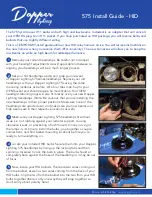
Driving your vehicle
48
5
Steps for determining correct load
limit
1. Locate the statement "The com-
bined weight of occupants and
cargo should never exceed XXX
kg or XXX lbs.'' on your vehicle's
placard.
2. Determine the combined weight of
the driver and passengers that will
be riding in your vehicle.
3. Subtract the combined weight of
the driver and passengers from
XXX kg or XXX lbs.
4. The resulting figure equals the
available amount of cargo and lug-
gage load capacity. For example, if
the "XXX" amount equals 1400
lbs. (635 kg), and there will be five
150 lbs. (68 kg) passengers in
your vehicle, the amount of avail-
able cargo and luggage load
capacity is 650 lbs. (295 kg).
(1400-750 (5 x 150) = 650 lbs. or
635-340 (5 x 68) = 295 kg)
5. Determine the combined weight of
luggage and cargo being loaded
on the vehicle. That weight may
not safely exceed the available
cargo and luggage load capacity
calculated in Step 4.
6. If your vehicle will be towing a
trailer, load from your trailer will be
transferred to your vehicle. Consult
this manual to determine how this
reduces the available cargo and
luggage load capacity of your
vehicle.
C190F01JM
Item
Description
Total
A
Vehicle Capacity 1400 lbs
Weight
(635 kg)
Subtract Occupant
B
Weight
300 lbs
150 lbs (68 kg) × 2
(136 kg)
C
Available Cargo and 1100 lbs
Luggage weight
(499 kg)
Example 1
A
B
C
Summary of Contents for 2007 Elantra
Page 1: ......
Page 8: ......
Page 17: ...2 Interior overview 2 2 Instrument panel overview 2 3 Your vehicle at a glance ...
Page 328: ...9 Dimensions 9 2 Bulb wattage 9 2 Tires and wheels 9 3 Specifications ...
Page 333: ...I Index ...
Page 339: ......
















































